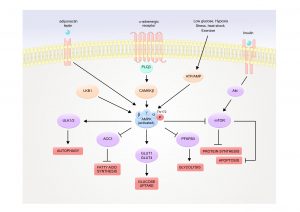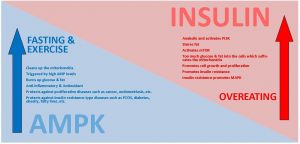Weight Loss – AMPK, Insulin and MAPK
For a long time the secret to weight loss has been advocated as ‘calories in’ versus ‘calories out’.
Well, I’m here to tell you that this is a fairly outdated model of looking at weight loss and also the reason why going on a “diet” or starving themselves do not work for many people. More often than not it is the hormone and peptide signalling that occurs within each individual’s unique biochemistry that dictates whether they are burning or storing fat.
To illustrate this point we need to delve a bit into biochemistry.
So let’s start with AMPK…
WHAT IS AMPK?
AMPK (5’adenosine monophosphate-activated protein kinase) is a protein that senses or monitors the levels of AMP. When you burn energy/ATP you are left with the ‘spent’ energy molecule AMP.
- High ATP = high energy state (3 phosphate groups)
- High AMP = low energy state (1 phosphate group)
AMKP will sense when your energy reserves run low and you need to produce more energy as is found with high AMP levels. This makes AMPK the protein that will stimulate processes in the body to make more energy through burning fat, burning glucose, stimulating the mitochondria (where energy is produced) and reducing things that will slow these processes down such as inflammation.
Do we want to stimulate AMPK?
Yes!
AMPK also improves mitochondrial function by breaking down the ‘garbage’ in the cells and using it as building blocks for new cellular components. A bit like demolishing a building and recycling the building material to build a new house.
It also stimulates the production of more mitochondria and increases VO2max and aerobic fitness. Even in the absence of exercise.
HOW INSULIN IS DIFFERENT TO AMPK
Insulin is the exact opposite of AMPK. It lets the cells know that food is on the way and so upregulates nutrient uptake receptors on the cells via PI3K (phosphatidylinositide 3-kinase).
The job of insulin is to allow for more building blocks to repair cells and muscles, and remove glucose out of the blood stream that could potentially cause damage to the blood vessels.
This makes insulin an important hormone in both weight loss and cardiovascular disease, but it needs to be balanced.
INSULIN RESISTANCE
We’ve spoken about Insulin Resistance (IR) before in the article:
Peptides and Weight Loss – Focus on Leptin
We discussed how more insulin has to be secreted in the presence of Insulin Resistance (IR) to try and get the body to respond. This high amount of circulating insulin causes the PI3K pathway to become suppressed and activates the MAPK (Mitogen-Activated Protein Kinases) pathway instead of the AMPK pathway.
SO WHAT IS MAPK?
The MAPK (Mitogen-Activated Protein Kinases) pathway is another pathway that depends mainly on insulin to trigger or activate it.
MAPK is upregulated when blood insulin levels are high, such as what we experience in Insulin Resistance (IR). This MAPK pathway promotes uncontrolled cell proliferation and loss of muscle mass when it becomes over-active, and we commonly see this happening in conditions such as:
- PCOS (polycystic ovarian disease) and acne
- Atherosclerosis
- Hypertension
- Cancer
So do we want to suppress MAKP?
Yes!
This brings us to PPAR.
WHAT IS PPAR?
PPAR (Peroxisome Proliferator Activated Receptor) enzymes are found in high amounts in the muscle, liver and fat tissues.
NEED TO EXPAND MORE HERE
WHAT IS PGC-1α?
PGC-1α (Peroxisome Proliferator-activated receptor gamma coactivator 1-alpha) stimulates mitochondrial production in all cells.
You may have heard of the term ‘brown fat’ and ‘white fat’ and how babies have more brown fat and obese individuals have more white fat.
The more mitochondria fat cells or adipocytes contain, the more brown it will be in appearance. Brown fat is linked to higher metabolism and weight loss whereas white fat is linked to obesity.
HIIT EXERCISE
High Intensity Interval Training (HIIT) is extremely effective at upregulation AMPK levels and substantial mitochondrial adaptation. Exercising at maximum capacity for 8-30 seconds repeated numerous times with rest periods in between can increase PGC-1α up to 4x!
It is not the calories you burn during exercise that we need to look at, but the cellular adaptations that occur as a result of exercise or after exercise that are the most important. These adaptations deplete carbohydrate stores and switches the body into fat-burning mode for up to 24 hours after exercise.
But all exercise is beneficial in their own ways. Mixing it up and including different forms is best in the long run.
In Conclusion…
WHAT CAN YOU DO HERE TO PROMOTE WEIGHT LOSS?
Stimulate AMPK
Stimulating AMPK levels can be done through:
- Calorie restriction
- Intermittent fasting
- Ketogenic diet
- Exercise (Fasted Exercise being better)
Remember that a ketogenic diet mimics the effects of fasting in the body.
There are also food substances that can stimulate AMPK production, such as:
- Cocoa (bitter, unrefined)
- Cinnamon
- Turmeric
- Resveratrol
- EGCG (green tea)
- Genistein (soy)
- Myricetin (walnuts)
Don’t Be Comfortable
By stressing your mitochondria through exercise or reducing calories you will activate the AMPK pathway. It’s literally ‘survival of the fittest’.
When your body gets food when it wants and you only rest you become weak.
As simple as that.
When you get out of your comfort zone, experience fatigue through exercise, hunger through reduced eating and depletion of ATP your body will adapt and will become stronger and leaner.
Reduce Insulin Secretion
How do we do this?
Eating less carbohydrates and sugar is the first and most important step. It gets immediate results.
Over time Insulin Resistance (IR) will improve, or you can speed this process up with minerals such as:
- Magnesium
- Chromium
- Vanadium
and other nutrients such as:
- Taurine
- Glycine
- Alpha lipoic acid (ALA)
As you can see there are methods within your control to manipulate these peptides and enhance your ability to lose weight.
Forget calorie counting and start working with your body’s signalling mechanisms for successful long term weight management.







you are awesome
Thank you David. Really humbled.
Great article Elizma! Thanks very much for explaining this in as simple terms as possible :). I live in Canada and there’s a Nephrologist here working primarily with Type 2 diabetes patients (Dr. Jason Fung) who highly touts the benefits of fasting, and has written a great book about it. In his book he mentions several possible benefits that appear to come more exclusively from “True” fasting, as opposed to LCHF / keto diets / intermittent fasting, although he is a proponent of these strategies as well. The true fasting benefits he mentions include such things as; a significant increase in HGH levels after ~48 hours of fasting, an increase in the basal metabolic rate (exact opposite of what seems to happen in calorie-restricted diets) and finally autophagy, all of which he seems to indicate requires a longer period of true fasting, and it appeared that he had some solid data to support this. Just wondering if you have any knowledge in these areas and whether you could confirm or comment on any of these possible benefits?
Thanks so much for taking the time to educate us! Cheers, Joe
Hi Joe,
Glad you enjoyed the article :). I’m aware of Dr. Jason Fung’s work and have great respect for him. I am aware of the rise in HGH levels with fasting, increased metabolic rate and autophagy. Often test results get skewed because of fasting due to compensatory mechanisms that may be construed as disadvantageous if you don’t know how to interpret the results. In essence I agree with his theories. You may find this article that I wrote for ATP Science interesting as well which focuses more on the thyroid aspect of fasting.
https://au.atpscience.com/fasting-and-thyroid-health-detrimental/